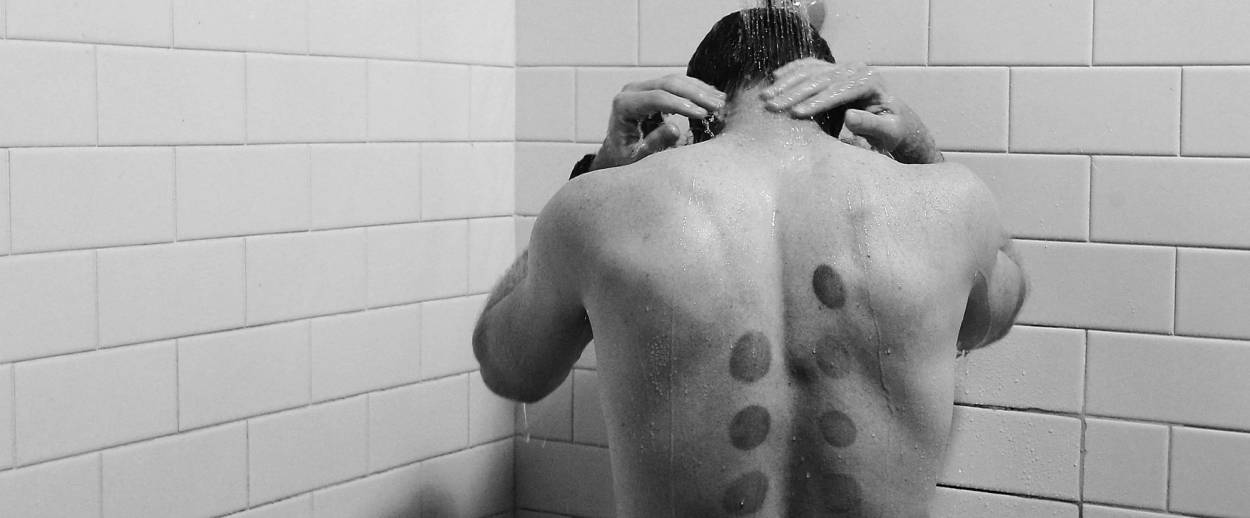Everything You Ever Wanted to Know About Cupping—and Some Stuff You Probably Didn’t
The practice of questionable efficacy has had its adherents from Maimonides to Michael Phelps




Feh. I’m over everyone acting all nutty about the circles on Michael Phelps’ back. How quickly we forget, America! We got into a tizzy when Gwyneth Paltrow did this a scant few years ago! (Michael Phelps, get back to me when you start steaming your vagina.) Jennifer Aniston was a cupper three years ago! You can see old photos of Victoria Beckham with cup marks surrounding the Hebrew tattoo on her spine! A few months back, Samuel L. Jackson Instagrammed a pic of his naked back completely covered in cups and acupuncture needles, because Samuel L. Jackson does not do anything by halves.
But I guess when cupping escapes the celebrity pages for the sports page, people (dudes) (dudes who write about sports) start paying attention. So mazel tov to Michael Phelps, who can perhaps or perhaps not credit the circle-shaped stamps on his shoulders and thighs for his smashing of a 2,168-year-old Olympic record. (Securing his 12th individual gold meant he tied for the most individual wins in Olympic history with Leonidas of Rhodes, who rocked the sprinting and long-distance running world in 152 BC. Sorry, Leonidas.)
Lazy journalists have stated that cupping—which involves using a heated cup to create a seal against a person’s skin, bringing blood to the surface—is ancient Chinese medicine, and it is. But it’s been part of lots of different cultures’ healing traditions. Our own Maimonides recommended cupping on the lower back for patients suffering from hemorrhoids. The 1550 BCE Ebers Papyrus, one of the oldest extant medical texts in the world, talks up ancient Egyptian cupping (which was paired with bloodletting, a combo Maimonides also recommended in cases of poisoning). Around 400 BCE, the Greek “father of modern medicine” Hippocrates advocated it for musculoskeletal injuries, lung diseases and gynecological issues. Eastern Europe in the Middle Ages and later was a veritable hotbed of cupping.
In fact, cupping was so integral to Eastern European Jewish tradition, there was even a Yiddish proverb about it: “Es vet helfn vi a toytn bankes.” That means, “It will be as helpful as cupping a corpse.” (In other words: Not so helpful.) Marjorie Gottlieb Wolfe, author of Are Yentas, Kibitzers and Tummlers Weapons of Mass Destruction? noted a Leo Rosten usage of the proverb: When Mrs. Kitzman, a fat lady, brought home a new size 12 dress and a new miracle girdle to help her get into it, Rosten noted, “It will help vi a toyten bankes!”
Wolfe also quotes an old article about how to use “binkes” or “bincus.” (Alternate spellings: “bahnkes,” “bankes,” and “bonkes.”) Take “small glasses that resemble whiskey (‘shnaps’) [sic] glasses, but are round,” put them in boiling water, take them out with tongs, heat the insides with a lit candle, then place them on a patient’s back. Do this in rows. Leave them there “until they are ready to pop off,” a half-hour or so. (Today, most cupping practitioners leave the devices in place for no longer than 10 minutes.) “Brown polka dots” will appear, and eventually disappear. Wolfe quotes an 81-year-old man who possessed a set of the cups used by his grandfather, a barber in Poland in the late 1800s, when barbers frequently acted as doctors.
Does cupping work? Depends on who you ask. A 2012 study by Chinese researchers published in the journal PLoS ONE reviewed 135 studies of cupping published since 1992 and found that cupping may indeed be effective for a variety of complaints, to a greater degree than might be explained by the placebo effect. (The researchers did note that not all the studies in the survey were well-designed.) Other small studies on pain, muscle fatigue and arthritis have found cupping effective, but noted that its efficacy couldn’t be separated from the placebo effect. A 2014 article in the Journal of Traditional Chinese Medical Sciences looked at the results of 16 cupping trials with 921 participants and found, again, that many studies have been poorly designed, but that there was still “potential positive short-term effect of cupping therapy on reducing pain intensity compared with no treatment, heat therapy, usual care of conventional drugs.” A 2015 review of the literature published in the July 2015 Journal of Traditional and Complementary Medicine by two researchers at the Poona College of Pharmacy in India concluded that “cupping therapy maintains a strong historical account that needs to be rejuvenated in modern times,” but noted that it should not be used on “excoriated, oozing or infected areas.” Yes, good idea.
Friends, I myself have been cupped. Back in the mid-’90s, when this treatment was not yet a gleam in Michael Phelps’s eye (mainly because he was born in 1985), I was a columnist specializing in destination spas for Fit Magazine (RIP). A writer can only describe so many massages, so I sought out the quirkiest treatments I could find. At Lake Austin Spa Resort in Texas, I received a treatment that combined cupping with “manaka tapping,” in which a wooden peg is placed on your acupressure points and tapped with a small wooden hammer to the beat of a metronome, in sets of 18 (chai!). The manaka tapping was like water torture. I wanted to flee. The cupping, however, which was quiet, felt amazing. There was pressure and warmth, but no pain. I recommend it.
So whether the benefits of cupping are due to the placebo effect or to increased blood flow or to cleared-up meridians or chi in the body, who cares? Science has shown that placebos can have meaningful, positive results, even when the person receiving the treatment knows they’re getting a placebo. Cup away.
Marjorie Ingall is a former columnist for Tablet, the author of Mamaleh Knows Best, and a frequent contributor to the New York Times Book Review.